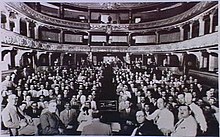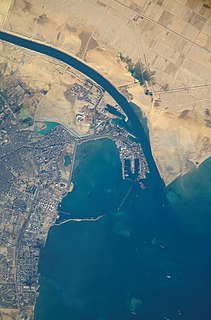
The Suez Canal is an artificial sea-level waterway in Egypt, connecting the Mediterranean Sea to the Red Sea through the Isthmus of Suez and dividing Africa and Asia. The canal is a route of trade between Europe and Asia.

The Treaty of Amiens temporarily ended hostilities between France and the United Kingdom at the end of the War of the Second Coalition. It marked the end of the French Revolutionary Wars; after a short peace it set the stage for the Napoleonic Wars. Britain gave up most of its recent conquests; France was to evacuate Naples and Egypt. Britain retained Ceylon and Trinidad. It was signed in the city of Amiens on 25 March 1802 by Joseph Bonaparte and Marquess Cornwallis as a "Definitive Treaty of Peace." The consequent peace lasted only one year and was the only period of general peace in Europe between 1793 and 1814.

Port Said is a city that lies in north east Egypt extending about 30 km (19 mi) along the coast of the Mediterranean Sea, north of the Suez Canal. With an approximate population of 603,787 (2010), it is the fifth-largest city in Egypt. The city was established in 1859 during the building of the Suez Canal.

Ferdinand Marie, Count de Lesseps was a French diplomat and later developer of the Suez Canal, which in 1869 joined the Mediterranean and Red Seas, substantially reducing sailing distances and times between Europe and East Asia.

The ʻUrabi revolt, also known as the ʻUrabi Revolution, was a nationalist uprising in Egypt from 1879 to 1882. It was led by and named for Colonel Ahmed ʻUrabi and sought to depose the Khedive Tewfik Pasha and end British and French influence over the country. The uprising was ended by an Anglo-Egyptian War and takeover of the country. Thus began the History of Egypt under the British.
1798 was a relatively quiet period in the French Revolutionary Wars. The major continental powers in the First coalition had made peace with France, leaving France dominant in Europe with only a slow naval war with Great Britain to worry about. The leaders of the Directory in Paris feared Napoleon Bonaparte's popularity after his victories in Italy, so they were relieved when he proposed to depart France and mount an expedition to Egypt to gain further glory.
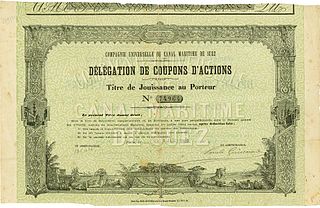
The Universal Company of the Maritime Canal of Suez was the concessionary company that constructed the Suez Canal between 1859 and 1869 and operated it until the Suez Crisis that had occurred in 1956. It was formed by Ferdinand de Lesseps in 1858, and it operated the canal for many years thereafter. Initially, French private investors were the majority of the shareholders, with Egypt also having a significant stake.

The Eyalet of Egypt operated as an administrative division of the Ottoman Empire from 1517 to 1867. It originated as a result of the conquest of Mamluk Egypt by the Ottomans in 1517, following the Ottoman–Mamluk War (1516–17) and the absorption of Syria into the Empire in 1516. The Ottomans administered Egypt as an eyalet of their Empire from 1517 until 1867, with an interruption during the French occupation of 1798 to 1801.

The Maltese people are a nation and ethnic group indigenous to Malta who speak Maltese, a Semitic language. Malta is an island in the middle of the Mediterranean Sea. Included within the ethnic group defined by the Maltese people are the Gozitans who inhabit Malta's sister island, Gozo.

The French campaign in Egypt and Syria (1798–1801) was Napoleon Bonaparte's campaign in the Ottoman territories of Egypt and Syria, proclaimed to defend French trade interests, to establish scientific enterprise in the region and ultimately to join the forces of Indian ruler Tipu Sultan and drive away the British from the Indian subcontinent. It was the primary purpose of the Mediterranean campaign of 1798, a series of naval engagements that included the capture of Malta. The campaign ended in defeat for Napoleon, and the withdrawal of French troops from the region.
Italians in Egypt, also referred to as Italian Egyptians, are a community with a history that goes back to Roman times.

Suez is an American romantic drama film released on October 28, 1938 by 20th Century Fox, with Darryl F. Zanuck in charge of production, directed by Allan Dwan and starring Tyrone Power, Loretta Young, and Annabella. It is very loosely based on events surrounding the construction, between 1859 and 1869, of the Suez Canal, planned and supervised by French diplomat Ferdinand de Lesseps. The screenplay is so highly fictionalized that, upon the film's release in France, de Lesseps' descendants sued (unsuccessfully) for libel.

The Khedivate of Egypt was an autonomous tributary state of the Ottoman Empire, established and ruled by the Muhammad Ali Dynasty following the defeat and expulsion of Napoleon Bonaparte's forces which brought an end to the short-lived French occupation of Lower Egypt. The Khedivate of Egypt had also expanded to control present-day Sudan, South Sudan, Eritrea, Djibouti, northern Somalia, Israel, Lebanon, Jordan, Syria, Greece, Cyprus, southern and central Turkey, in addition to parts from Libya, Chad, Central African Republic, and Democratic Republic of Congo, as well as northwestern Saudi Arabia, parts of Yemen and the Kingdom of Hejaz.
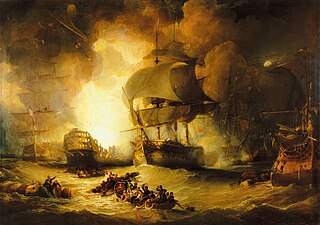
The Mediterranean campaign of 1798 was a series of major naval operations surrounding a French expeditionary force sent to Egypt under Napoleon Bonaparte during the French Revolutionary Wars. The French Republic sought to capture Egypt as the first stage in an effort to threaten British India and support Tipu Sultan, and thus force Great Britain to make peace. Departing Toulon in May 1798 with over 40,000 troops and hundreds of ships, Bonaparte's fleet sailed southeastwards across the Mediterranean Sea. They were followed by a small British squadron under Rear-Admiral Sir Horatio Nelson, later reinforced to 13 ships of the line, whose pursuit was hampered by a lack of scouting frigates and reliable information. Bonaparte's first target was the island of Malta, which was under the government of the Knights of St. John and theoretically granted its owner control of the Central Mediterranean. Bonaparte's forces landed on the island and rapidly overwhelmed the defenders, securing the port city of Valletta before continuing to Egypt. When Nelson learned of the French capture of the island, he guessed the French target to be Egypt and sailed for Alexandria, but passed the French during the night of 22 June without discovering them and arrived off Egypt first.
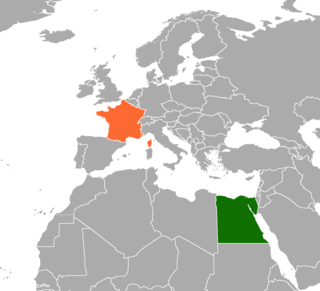
Egypt–France relations, also known as Egyptian-French relations, refer to the bilateral relationship between Egypt and France. Relations between the two countries have spanned centuries, from the Middle Ages to the present day. Following the French occupation of Egypt (1798-1801), a strong French presence has remained in Egypt. Egyptian influence is also evident in France, in monuments such as the Luxor Obelisk in Paris. The relationship is also marked by conflicts like the Algerian War (1954-1962) and the Suez Crisis (1956). As of 2020, relations are strong and consist of shared cultural activities such as the France-Egypt Cultural Year (2019), tourism, diplomatic missions, trade, and a close political relationship. Institutions like the Institut d’Égypte, the French Institute in Egypt and the French University of Egypt (UFE) also aid in promoting cultural exchange between Egypt and France.

The history of Egypt under the British lasts from 1882, when it was occupied by British forces during the Anglo-Egyptian War, until 1956 after the Suez Crisis, when the last British forces withdrew in accordance with the Anglo-Egyptian agreement of 1954. The first period of British rule (1882–1914) is often called the "veiled protectorate". During this time the Khedivate of Egypt remained an autonomous province of the Ottoman Empire, and the British occupation had no legal basis but constituted a de facto protectorate over the country. Egypt was thus not part of the British Empire. This state of affairs lasted until 1914 when the Ottoman Empire joined the First World War on the side of the Central Powers and Britain declared a protectorate over Egypt. The ruling khedive was deposed and his successor, Hussein Kamel, compelled to declare himself Sultan of Egypt independent of the Ottomans in December 1914.
The 1956–57 exodus and expulsions from Egypt was the exodus and expulsion of Egypt's Mutamassirun, which began during the latter stages of the Suez Crisis in Nasserist Egypt.
Anarchism in Egypt refers both to the historical Egyptian anarchist movement which emerged in the 1860s and lasted until the 1940s, and to the anarchist movement as it has re-emerged in the early 2000s. Anarchism was first introduced to Egypt by Italian immigrant workers and political exiles in the 1860s. The Italian community in Egypt was one of numerous such communities of expatriate workers whose presence in Egypt dated to the modernisation programme of Muhammad Ali, Wāli of Egypt from 1805 to 1849, as part of which the immigration of foreigners with useful skills was encouraged. This process was accelerated under Ali's successors, in particular with the construction of the Suez Canal in the 1850s.

The French occupation of Malta lasted from 1798 to 1800. It was established when the Order of Saint John surrendered to Napoleon Bonaparte following the French landing in June 1798. In Malta, the French established a constitutional tradition in Maltese history, granted free education for all, and theoretically established freedom of the press, although only the pro-French newspaper Journal de Malte was actually published during the occupation.

Emigration from Malta was an important demographic phenomenon throughout the nineteenth and twentieth centuries, leading to the creation of large Maltese communities in English-speaking countries abroad.
